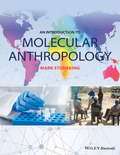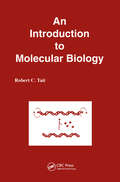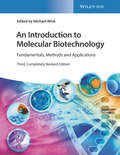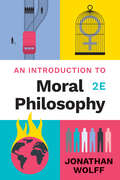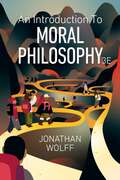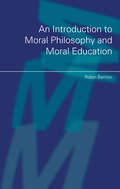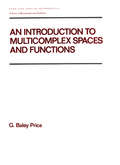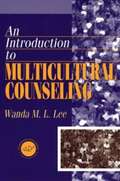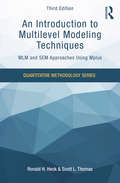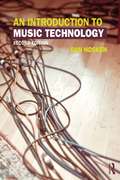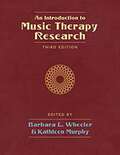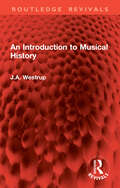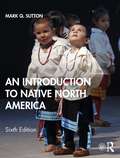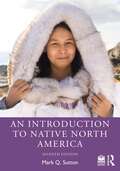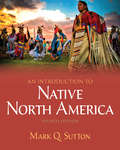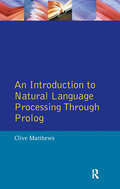- Table View
- List View
An Introduction to Modern Japanese
by Richard Bowring Haruko Ury LaurieThis is the first book in a two-volume intensive one-year introductory course in Japanese, also suitable for those who wish to work at a slower pace. Students who finish this course will have a firm grasp of how the language works and enough knowledge of the writing system to tackle everyday written material with no more than a dictionary. Particular attention is paid to questions of grammar which foreign learners often find difficult, so Book One can also serve as a reference grammar. An Introduction to Modern Japanese uses both spoken and written forms from the outset. There are word lists for each lesson, and a comprehensive vocabulary for the whole course. Book One comprises fifty-two lessons which are accompanied by exercises and word lists in Book Two. The exercises ensure that the student has understood the grammar explained in the relevant lessons and give further practice in reading and recognising characters. Book Two also contains a full vocabulary, Japanese to English and English to Japanese.
An Introduction to Modern Japanese
by Richard Bowring Haruko Ury LaurieThis is the first book in a two-volume intensive one-year introductory course in Japanese, also suitable for those who wish to work at a slower pace. Students who finish this course will have a firm grasp of how the language works and enough knowledge of the writing system to tackle everyday written material with no more than a dictionary. Particular attention is paid to questions of grammar which foreign learners often find difficult, so Book One can also serve as a reference grammar. An Introduction to Modern Japanese uses both spoken and written forms from the outset. There are word lists for each lesson, and a comprehensive vocabulary for the whole course. Book One comprises fifty-two lessons which are accompanied by exercises and word lists in Book Two. The exercises ensure that the student has understood the grammar explained in the relevant lessons and give further practice in reading and recognising characters. Book Two also contains a full vocabulary, Japanese to English and English to Japanese.
An Introduction to Modern Timekeeping and Time Transfer (Springer Series in Measurement Science and Technology)
by Parameswar Banerjee Demetrios MatsakisThis book provides a comprehensive, systematic description of modern timekeeping and its specializations. Introductory chapters discuss the concept of time and its definition, then briefly look at pre-Atomic Era timekeeping to set the stage for the introduction of the atomic clock. Subsequent chapters focus on concepts such as frequency stability and measurement uncertainty, as well as computer network time-synchronization protocols including Network Time Protocol (NTP) and Precise Time Protocol (PTP). The book then delves into the nuts and bolts of the Global Navigation Satellite Systems (GNSS), Two-Way Satellite Time and Frequency Transfer, and Optical Time and Frequency Transfer. Timescale theory is then described as a way to combine clock data, and the algorithms and procedures used to generate Coordinated Universal Time (UTC) are given. Finally, there is a look at modern applications of timekeeping and time transfer.Featuring a glossary of all key terms, this book is highly recommended for trained or incoming physicists, engineers, or mathematicians working, for example, in manufacturing or timing laboratories. Additionally, it is suitable for use in introductory university courses dealing with the subject of timekeeping.
An Introduction to Molecular Anthropology
by Mark StonekingMolecular anthropology uses molecular genetic methods to address questions and issues of anthropological interest. More specifically, molecular anthropology is concerned with genetic evidence concerning human origins, migrations, and population relationships, including related topics such as the role of recent natural selection in human population differentiation, or the impact of particular social systems on patterns of human genetic variation. Organized into three major sections, An Introduction to Molecular Anthropology first covers the basics of genetics - what genes are, what they do, and how they do it - as well as how genes behave in populations and how evolution influences them. The following section provides an overview of the different kinds of genetic variation in humans, and how this variation is analyzed and used to make evolutionary inferences. The third section concludes with a presentation of the current state of genetic evidence for human origins, the spread of humans around the world, the role of selection and adaptation in human evolution, and the impact of culture on human genetic variation. A final, concluding chapter discusses various aspects of molecular anthropology in the genomics era, including personal ancestry testing and personal genomics. An Introduction to Molecular Anthropology is an invaluable resource for students studying human evolution, biological anthropology, or molecular anthropology, as well as a reference for anthropologists and anyone else interested in the genetic history of humans.
An Introduction to Molecular Biology
by 0 R.C. Tait,This book explains molecular biology concepts clearly and in practical terms. It represents an invaluable introduction to molecular biology for undergraduates, postgraduates, researchers, lecturers, medics, nurses, teachers, scientists, editors, and all t
An Introduction to Molecular Biotechnology: Fundamentals, Methods and Applications
by Michael WinkMolecular biotechnology continues to triumph, as this textbook testifies - edited by one of the academic pioneers in the field and written by experienced professionals. This completely revised second edition covers the entire spectrum, from the fundamentals of molecular and cell biology, via an overview of standard methods and technologies, the application of the various "-omics", and the development of novel drug targets, right up to the significance of system biology in biotechnology. The whole is rounded off by an introduction to industrial biotechnology as well as chapters on company foundation, patent law and marketing. The new edition features: - Large format and full color throughout - Proven structure according to basics, methods, main topics and economic perspectives - New sections on system biology, RNA interference, microscopic techniques, high throughput sequencing, laser applications, biocatalysis, current biomedical applications and drug approval - Optimized teaching with learning targets, a glossary containing around 800 entries, over 500 important abbreviations and further reading. The only resource for those who are seriously interested in the topic. Bonus material available online free of charge: www.wiley-vch.de/home/molecbiotech
An Introduction to Molecular Biotechnology: Fundamentals, Methods and Applications
by Michael WinkCompletely updated in line with the rapid progress made in the field, this new edition of the highly-praised textbook addresses powerful new methods and concepts in biotechnology, such as genome editing, reprogrammed stem cells, and personalized medicine. An introduction to the fundamentals in molecular and cell biology is followed by a description of standard techniques, including purification and analysis of biomolecules, cloning techniques, gene expression systems, genome editing methods, labeling of proteins and in situ-techniques, standard and high resolution microscopy. The third part focuses on key areas in research and application, ranging from functional genomics, proteomics and bioinformatics to drug targeting, recombinant antibodies and systems biology. The final part looks at the biotechnology industry, explaining intellectual property issues, legal frameworks for pharmaceutical products and the interplay between start-up and larger companies. The contents are beautifully illustrated throughout, with hundreds of full color diagrams and photographs. Provides students and professionals in life sciences, pharmacy and biochemistry with everything they need to know about molecular biotechnology.
An Introduction to Moral Philosophy (Second Edition)
by Jonathan WolffThe most contemporary and applicable introduction to moral philosophy From respected philosopher and writer Jonathan Wolff, this brief introduction to ethics stimulates independent thought, emphasizes real-world examples, and provides clear and engaging introductions to key moral theories and the thinkers behind them. The new Second Edition offers expanded coverage of moral reasoning, as well as two thoughtful and contemporary new chapters on applying moral philosophy and the ethics of race. A companion primary source collection, Readings in Moral Philosophy, amplifies issues discussed in the text, connecting them to problems in applied ethics.
An Introduction to Moral Philosophy (Third Edition)
by Jonathan WolffEmpower students to think critically about ethical theories and moral dilemmas. From his influential scholarship to his popular writings to his appearances on the BBC, Jonathan Wolff has a knack for making moral philosophy vivid and exciting for any audience. In An Introduction to Moral Philosophy, he wields this talent to deliver a text that students enjoy reading. In addition to surveying the basics of ethical theory and critical thinking, Wolff guides students through debates about some of today’s most urgent moral issues, including the ethics of race, gender, artificial intelligence, and public health. The text invites students to think for themselves about real-world issues and provides them with an accurate, appealing sense of what moral philosophy is all about. This purchase offers access to the digital ebook only.
An Introduction to Moral Philosophy and Moral Education
by Robin BarrowThis book presents and argues for a moral theory which draws on most of the major theoretical positions to some degree, but it also spells out the limits and boundaries of a moral theory. In doing so, it exposes a number of common confusions and misunderstandings about morality, and presents a strong argument for some indisputable truths in relation to the moral sphere. Divided into four parts, the book covers the key issues within moral philosophy: part one provides a lucid and powerful account of the nature and limits of moral theory, sharply distinguishing it from religion part two outlines a positive moral theory by exploring the defining principles of morality and the reasons for being moral part three distinguishes moral values from others such as ecological, health and safety and sexual values part four is concerned with the implications of our moral understanding for moral education. While this book concentrates on argument and ideas, a commentary to each chapter provides historical context and contemporary reference points. It will prove an invaluable resource for students of both Education and Philosophy.
An Introduction to Multicomplex SPates and Functions (Chapman And Hall/crc Pure And Applied Mathematics Ser. #140)
by PriceA rather pretty little book, written in the form of a text but more likely to be read simply for pleasure, in which the author (Professor Emeritus of Mathematics at the U. of Kansas) explores the analog of the theory of functions of a complex variable which comes into being when the complexes are re
An Introduction to Multicultural Counseling
by Wanda M. L. LeeA history of multicultural counseling, its current issues and controversies, along with historical and sociopolitical influences in treatment methods and in testing biases.
An Introduction to Multilevel Modeling Techniques: MLM and SEM Approaches Using Mplus (Quantitative Methodology Series)
by Ronald H. Heck Scott L. ThomasMultilevel modelling is a data analysis method that is frequently used to investigate hierarchal data structures in educational, behavioural, health, and social sciences disciplines. Multilevel data analysis exploits data structures that cannot be adequately investigated using single-level analytic methods such as multiple regression, path analysis, and structural modelling. This text offers a comprehensive treatment of multilevel models for univariate and multivariate outcomes. It explores their similarities and differences and demonstrates why one model may be more appropriate than another, given the research objectives. New to this edition: An expanded focus on the nature of different types of multilevel data structures (e.g., cross-section, longitudinal, cross-classified, etc.) for addressing specific research goals Varied modelling methods for examining longitudinal data including random-effect and fixed-effect approaches Expanded coverage illustrating different model-building sequences and how to use results to identify possible model improvements An expanded set of applied examples used throughout the text Use of four different software packages (i.e., Mplus, R, SPSS, Stata), with selected examples of model-building input files included in the chapter appendices and a more complete set of files available online This is an ideal text for graduate courses on multilevel, longitudinal, latent variable modelling, multivariate statistics, or advanced quantitative techniques taught in psychology, business, education, health, and sociology. Recommended prerequisites are introductory univariate and multivariate statistics.
An Introduction to Multilevel Modeling Techniques: MLM and SEM Approaches Using Mplus, Third Edition (Quantitative Methodology Series )
by Ronald H. Heck Scott L. ThomasUnivariate and multivariate multilevel models are used to understand how to design studies and analyze data in this comprehensive text distinguished by its variety of applications from the educational, behavioral, and social sciences. Basic and advanced models are developed from the multilevel regression (MLM) and latent variable (SEM) traditions within one unified analytic framework for investigating hierarchical data. The authors provide examples using each modeling approach and also explore situations where alternative approaches may be more appropriate, given the research goals. Numerous examples and exercises allow readers to test their understanding of the techniques presented. Changes to the new edition include: -The use of Mplus 7.2 for running the analyses including the input and data files at www.routledge.com/9781848725522. -Expanded discussion of MLM and SEM model-building that outlines the steps taken in the process, the relevant Mplus syntax, and tips on how to evaluate the models. -Expanded pedagogical program now with chapter objectives, boldfaced key terms, a glossary, and more tables and graphs to help students better understand key concepts and techniques. -Numerous, varied examples developed throughout which make this book appropriate for use in education, psychology, business, sociology, and the health sciences. -Expanded coverage of missing data problems in MLM using ML estimation and multiple imputation to provide currently-accepted solutions (Ch. 10). -New chapter on three-level univariate and multilevel multivariate MLM models provides greater options for investigating more complex theoretical relationships(Ch.4). -New chapter on MLM and SEM models with categorical outcomes facilitates the specification of multilevel models with observed and latent outcomes (Ch.8). -New chapter on multilevel and longitudinal mixture models provides readers with options for identifying emergent groups in hierarchical data (Ch.9). -New chapter on the utilization of sample weights, power analysis, and missing data provides guidance on technical issues of increasing concern for research publication (Ch.10). Ideal as a text for graduate courses on multilevel, longitudinal, latent variable modeling, multivariate statistics, or advanced quantitative techniques taught in psychology, business, education, health, and sociology, this book’s practical approach also appeals to researchers. Recommended prerequisites are introductory univariate and multivariate statistics.
An Introduction to Music Technology
by Dan HoskenAn Introduction to Music Technology, Second Edition provides a clear overview of the essential elements of music technology for today's musician. This book focuses on the topics that underlie the hardware and software in use today: Sound, Audio, MIDI, Computer Notation, and Computer- Assisted Instruction. Appendices cover necessary computer hardware and software concepts. Written for both music technology majors and non-majors, this textbook introduces fundamental principles and practices so students can learn to work with a wide range of software programs, adapt to new music technologies, and apply music technology in their performance, composition, teaching, and analysis. Features: Thorough explanations of key topics in music technology Content applicable to all software and hardware, not linked to just one piece of software or gear In-depth discussion of digital audio topics, such as sampling rates, resolutions, and file formats Explanations of standard audio plug-ins including dynamics processors, EQs, and delay based effects Coverage of synthesis and sampling in software instruments Pedagogical features, including: Further Reading sections that allow the student to delve deeper into topics of interest Suggested Activities that can be carried out with a variety of different programs Key Terms at the end of each chapter What Do I Need? Chapters covering the types of hardware and software needed in order to put together Audio and MIDI systems A companion website with links to audio examples that demonstrate various concepts, step-by-step tutorials, relevant hardware, software, and additional audio and video resources. The new edition has been fully updated to cover new technologies that have emerged since the first edition, including iOS and mobile platforms, online notation software, alternate controllers, and Open Sound Control (OSC).
An Introduction to Music Therapy Research
by Barbara L. WheelerAn introductory overview of how research has been conceived and implemented in music therapy over the last several decades. The book was designed for those who are beginning their studies in music therapy research, and it is especially well-suited for use as an accompaniment to classroom instruction. <P><P> Seventeen of the chapters were excerpted from Music Therapy Research (3rd Edition), a much larger volume of 68 chapters that gives considerable detail on numerous topics and sub-topics. In addition, three chapters (15, 16, 17) were specially written to provide a birds-eye view of some of the chapters that were not included, and in particular, those chapters in the larger book that examined the numerous methodological designs and approaches used in objectivist, interpretivist and other types of music therapy research.
An Introduction to Music Therapy Theory and Practice Third Edition
by William B. Davis Kate E. Gfeller Michael H. Thaut"An Introduction to Music Therapy: Theory and Practice, third edition, provides a comprehensive overview of the practice of music therapy for the 21st century. It looks at where we have been, where we are today, and where we might be in the future. Combining sound pedagogy with recent research findings, this new edition has been updated and expanded to reflect changes in music therapy practice over the past nine years.
An Introduction to Music and Art in the Western World (10th edition)
by Milo Wold Edmund Cykler Gary Martin James MillerAn undergraduate introduction to the music, painting, sculpture, and architecture of the Western world, featuring chapter objectives and summaries, pronunciation guides, and chronologies. Covers various periods from the ancient Greeks through the arts today, and includes material on the arts and society and the organization of the elements of art and music. This 10th edition contains increased recognition of women and minority artists, and boxes on selected individual works. Annotation c. by Book News, Inc., Portland, Or.
An Introduction to Musical History (Routledge Revivals)
by J.A. WestrupFirst published in 1955, An Introduction to Musical History is not just another short history of music, but a discussion of its sources and background. It explains how we derive our knowledge of the music of the past, and how music has been affected by its social and political background. Such topics as the influence of language and racial characteristics find their place here, as well as the contributions made by literature and painting. Some of the problems presented by musical history are examined, and an indication is given of the best method of studying it. This book will be an interesting read for students and researchers of music.
An Introduction to Narratology
by Monika FludernikAn Introduction to Narratology is an accessible, practical guide to narratological theory and terminology and its application to literature. In this book, Monika Fludernik outlines: the key concepts of style, metaphor and metonymy, and the history of narrative forms narratological approaches to interpretation and the linguistic aspects of texts, including new cognitive developments in the field how students can use narratological theory to work with texts, incorporating detailed practical examples a glossary of useful narrative terms, and suggestions for further reading. This textbook offers a comprehensive overview of the key aspects of narratology by a leading practitioner in the field. It demystifies the subject in a way that is accessible to beginners, but also reflects recent theoretical developments and narratology’s increasing popularity as a critical tool.
An Introduction to Native North America
by Mark Q. SuttonAn Introduction to Native North America provides a basic introduction to the Native Peoples of North America, covering what are now the United States, northern Mexico, and Canada. It covers the history of research, basic prehistory, the European invasion and the impact of Europeans on Native cultures. A final chapter covers contemporary Native Americans, including issues of religion, health, and politics. In this updated and revised new edition, Mark Q. Sutton has expanded and improved the existing text as well as adding a new case study, updated the text with new research, and included new perspectives, particularly those of Native peoples. Featuring case studies of several tribes, as well as over 60 maps and images, An Introduction to Native North America is an indispensable tool to those studying the history of North America and Native Peoples of North America. .
An Introduction to Native North America
by Mark Q. SuttonAn Introduction to Native North America provides a basic introduction to the Native peoples of North America, covering what are now the United States, northern Mexico, and Canada. In this updated and revised new edition, Mark Q. Sutton has expanded and improved the existing text, adding to the case studies, updating the text with the latest research, increasing the number of images, providing more coverage of the Arctic regions, and including new perspectives, particularly those of Native peoples. The book addresses the history of research, the European invasion, and the impact of Europeans on Native societies. A final chapter introduces contemporary Native Americans, discussing issues that affect them, including religion, health, and politics. The book retains a wealth of pedological features to aid and reinforce learning. Featuring case studies of many Native American groups, as well as some eighty-four maps and images, An Introduction to Native North America is an indispensable tool to those studying the history of North America and its Native peoples.
An Introduction to Native North America
by Mark Q. SuttonAn Introduction to Native North America provides a basic introduction to the Native peoples of North America, covering what are now the United States, northern Mexico, and Canada.In this updated and revised new edition, Mark Q. Sutton has expanded and improved the existing text, adding to the case studies, updating the text with the latest research, increasing the number of images, providing more coverage of the Arctic regions, and including new perspectives, particularly those of Native peoples. This book addresses the history of research, the European invasion, and the impact of Europeans on Native societies. A final chapter introduces contemporary Native Americans, discussing issues that affect them, including religion, health, and politics. The book retains a wealth of pedological features to aid and reinforce learning.Featuring case studies of many Native American groups, as well as some 87 maps and images, An Introduction to Native North America is an indispensable tool to those studying the history of North America and its Native peoples.
An Introduction to Native North America -- Pearson eText
by Mark Q. SuttonAn Introduction to Native North America provides a basic introduction to the native peoples of North America, including both the United States and Canada. It covers the history of research, basic prehistory, the European invasion and the impact of Europeans on Native cultures. Additionally, much of the book is written from the perspective of the ethnographic present, and the various cultures are described as they were at the specific times noted in the text. Teaching and Learning Experiences: Improve Critical Thinking - An Introduction to Native North America provides internet resources for students to supplement reading material, and contains an extensive bibliography to aid in their research. Engage Students - An Introduction to Native North America highlights important individuals in "VIP Profile" mini-biographies, and contains "Sidelights" throughout the text which provides short explanations of interesting aspects of native culture. Support Instructors - Teaching your course just got easier! You can create a Customized Text or use our Instructor's Manual, Electronic "MyTest" Test Bank or PowerPoint Presentation Slides. Plus, An Introduction to Native North America's organization was designed to be used in conjunction with the Handbook of North American Indians, published by the Smithsonian Institution.
An Introduction to Natural Language Processing Through Prolog (Learning about Language)
by Clive MatthewsResearch into Natural Language Processing - the use of computers to process language - has developed over the last couple of decades into one of the most vigorous and interesting areas of current work on language and communication. This book introduces the subject through the discussion and development of various computer programs which illustrate some of the basic concepts and techniques in the field. The programming language used is Prolog, which is especially well-suited for Natural Language Processing and those with little or no background in computing.Following the general introduction, the first section of the book presents Prolog, and the following chapters illustrate how various Natural Language Processing programs may be written using this programming language. Since it is assumed that the reader has no previous experience in programming, great care is taken to provide a simple yet comprehensive introduction to Prolog. Due to the 'user friendly' nature of Prolog, simple yet effective programs may be written from an early stage. The reader is gradually introduced to various techniques for syntactic processing, ranging from Finite State Network recognisors to Chart parsers. An integral element of the book is the comprehensive set of exercises included in each chapter as a means of cementing the reader's understanding of each topic. Suggested answers are also provided.An Introduction to Natural Language Processing Through Prolog is an excellent introduction to the subject for students of linguistics and computer science, and will be especially useful for those with no background in the subject.


